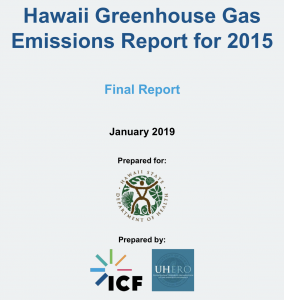Hawai‘i on Target to Beat 2020 Greenhouse Gas Emissions Goal
Rising sea levels and other effects of climate change are threats to the health and environment of the Hawaiian islands, but Hawai‘i is taking these threats seriously, based on findings in the Hawai‘i Greenhouse Gas Emissions Report released recently by the Hawai‘i Department of Health’s Clean Air Branch.
Projections in the report, prepared by ICF International and the University of Hawai‘i Economic Research Organization (UHERO) for the Department of Health, indicate Hawai‘i is on target to meet the state’s goal established by the legislature 12 years ago of reducing greenhouse gas emissions to equal to or below 1990 levels.
“We know that bending the curve of emissions down by 2020 gives the world the best opportunity to prevent the worst effects of climate change. Setting ambitious goals works. This report shows us that Hawaiʻi is on the right track and provides motivation to continue reducing greenhouse gas emissions,” said Gov. Ige.
“Hawai‘i is on the right path to mitigate the effects of climate change, but we must continue to stay on track,” said Dr. Bruce Anderson, health director. “The Department of Health requires greenhouse gas emission caps for the largest stationary sources of air pollution, and major sources of greenhouse gas emissions are taking responsibility for implementing the reductions. Everyone must do their part to continue these efforts.”
Data for 2015 on greenhouse gas emissions, primarily carbon dioxide, combined with data on “sinks” that remove carbon dioxide from the atmosphere, were captured in the report. Sinks, made popular from the Kyoto Protocol, includes such carbon offset activities as reforestation and urban trees. The report provides a number of key findings:
- The energy sector makes up the majority—87%—of the state’s greenhouse gas emissions. Approximately 53% of the energy sector emissions are from transportation, excluding international bunker fuel, and 45% are from stationary combustion.
- The decrease in transportation emissions, about 20% from 2007 to 2015, was the result of decreases in domestic marine, domestic aviation, and military emissions, which more than offset an increase in ground transportation.
- Stationary combustion emissions from electrical power plants and petroleum refineries decreased by about 15% over the five-year period from 2010 to 2015.
- Industrial processes and product use, which includes emissions from cement production, electrical transmission and distribution, and substitution of ozone depleting substances accounted for 4% of the state’s emissions in 2015.
- Agriculture, forestry, and other land use, which included emissions and sinks from agricultural activities, land use, changes in land use, and land management practices made up 5% of the statewide emissions in 2015.
- Waste, including emissions from waste management and treatment activities such as landfills, composting, and wastewater treatment, accounted for 4% of statewide emissions in 2015.
These positive trends are expected to continue, primarily because of the Hawai‘i Clean Energy Initiative, whose goal is to achieve 100% clean energy by 2045.
- Total state emissions are projected to decrease largely because of the combined decrease in emissions from electric power plants and petroleum refineries.
- Electric utilities, specifically, are seeking to meet the state’s “renewable portfolio standard” mandates which require increasing use of renewable energy sources to generate electricity until Hawai‘i is no longer dependent on fossil fuels and uses 100% of renewable energy sources by 2045.
- The state’s “energy efficiency portfolio standard target mandates a reduction in energy use—a decrease of 4,300 gigawatt-hours of electricity use by 2030. Based on the average efficiency of fossil fuel electricity generation in Hawai‘i, this would be equivalent to about 3.5 million metric tons of greenhouse gas removed.
Background
In the 2007 legislative session, Act 234 established a policy to reduce greenhouse gas emissions in the state to 1990 levels by 2020. The Department of Health established the Hawai‘i greenhouse gas program to track the state’s progress in reducing emissions to combat the threats of climate change. Hawai‘i Administrative Rules governing the Hawai‘i greenhouse gas program were amended in June 2014.
The report is based on data captured in 2015, the most recent figures available, and previous years. The greenhouse gas emission inventories are critical as they are used for decision making and to provide direction on the state’s future efforts to reduce greenhouse gas emissions. The Department of Health’s greenhouse gas emissions report for 2015 (dated January 2019) and summary of key results are available on the clean air branch’s Hawai‘i greenhouse gas program webpage.
State rules require the clean air branch to assess the state’s progress in achieving the reduction goal by determining statewide levels for the 2020 target date as well as the years leading up to and following it. The caps would no longer apply if the statewide greenhouse gas limit is met prior to 2020 and projections indicate the limit is being maintained.
A second Hawai‘i Greenhouse Gas Emissions Report is anticipated later this year which will include a new 2016 statewide greenhouse gas emissions inventory and updated prior year inventories and projections.
















